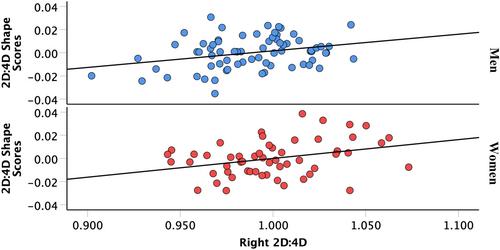Human sexual dimorphism in physical strength manifests itself in men having a greater muscle mass than women, reflecting ancestral roles in competition, protection, and provisioning. Prenatal testosterone exposure, approximated via the second-to-fourth digit ratio (2D:4D), is linked to increased muscular strength in both sexes, indicating a developmental influence. Previous research has shown that both physical strength and 2D:4D have facial shape correlates, especially in men, but most studies have focused on Western populations and one trait. We therefore hypothesized a broader relationship between facial shape and both physical strength and 2D:4D.
In this study, we quantified the association between facial shape, handgrip strength (HGS), and 2D:4D in a non-Western Turkish sample (72 men, 55 women; Md = 22 y, SIR = 1.8 y) using two dimensional geometric morphometrics. Thirty-eight somatometric and 32 semi-landmarks were digitized on facial photographs taken in frontal view. Physical strength was assessed via handgrip strength (HGS), and the second digit length was divided by the fourth digit length to calculate 2D:4D.
Both HGS and 2D:4D were significantly associated with shape in both sexes, but only in men did they explain a significant amount of facial variation. Thin-plates spline deformation grids and geometric morphometric morphs visualized the facial shape changes related to variations in handgrip strength, 2D:4D, and sexual dimorphism, enabling trait comparisons.
This study contributes a comparative sample from the Middle East, which is indispensable to discern universalities from Western peculiarities. It provides evidence to better understand the biological basis of facial traits, which can potentially serve as increasingly relevant social cues in today's online and digital environments.


